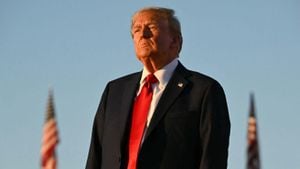With Donald Trump now back at the helm of the White House, the stage is set for another dramatic chapter in U.S. energy policy. His second term is expected to prioritize "energy dominance," echoing his previous administration's push for fossil fuels, which raises questions about the future of clean energy initiatives and environmental regulations. Energy markets, businesses, and political observers are already speculating how much his focus on oil and gas might shape the country’s energy agenda and its global climate commitments.
During his first term, Trump’s approach was marked by aggressive deregulatory measures. He famously withdrew the U.S. from the Paris Agreement and rolled back numerous environmental regulations aimed at curbing emissions. Now, analysts worry this pattern could re-emerge as Trump has made clear he intends to expand oil and gas production, minimize regulations, and fast-track drilling permits. His administration is likely to consist of Republican allies who support similar policies—an alarming prospect for advocates of climate action.
Economic factors played a central role during Trump’s recent campaign, especially inflation driven by fluctuatings fossil fuel prices. Consumers felt the crunch when energy prices spiked, contributing to the highest inflation rate since 1981. The Roosevelt Institute noted fossil fuels significantly influenced inflation, increasing costs across various sectors. With energy prices accounting for around one-third of the recent inflation surge, it's evident the economy and energy policy are closely intertwined.
Trump’s commitment to fossil fuels stands as a two-edged sword. While it caters to certain voter bases reliant on traditional energy jobs, it also threatens climate goals and the burgeoning clean energy sector. The Inflation Reduction Act (IRA), passed under Biden’s administration, has favored renewable energy investments and job growth substantially. Since its introduction, about 280 clean energy projects, totaling more than $282 billion, have been announced, creating at least 175,000 jobs, according to BNEF data. If Trump rolls back IRA provisions, it could undermine this growth, jeopardizing the U.S.'s standing as a clean energy leader.
Nevertheless, Trump’s first term unexpectedly coincided with significant growth within the renewable sector. Underlying factors include resilient market dynamics and continued consumer demand for cleaner energy sources. Many experts assert the future growth of clean energy won’t solely hinge on federal policies but will increasingly depend on market forces and state-level initiatives, which may outlast federal leadership changes.
Despite fears surrounding Trump's election, the global momentum toward climate action seems unyielded. Countries like China and India, previously doubtful about U.S. climate engagement, did not backtrack on their commitments to the Paris Agreement when Trump announced his intention to withdraw previously. Observers predict, whether or not the U.S. reverts to prior policies, international climate cooperation will persist, driven by economic imperatives and the urgency of climate threats.
Looking forward to COP29 and other international forums, Trump’s return could lead to significant shifts, but the world might not follow suit as much as he anticipates. Leaders from the European Union, Brazil, and other nations remain committed to combating climate change, actively seeking new partnerships aimed at addressing the climate crisis collectively. They are also strategizing ways to seize opportunities lost due to potential U.S. withdrawal from the clean tech narrative.
The commitment to climate finance by Biden’s administration was expected to exceed $11 billion by 2024, indicating global efforts are not tied entirely to U.S. contributions. For developing nations, fostering ambitious climate initiatives is increasingly viewed as non-negotiable regardless of U.S. policy changes. The 2024 scenario suggests these nations will focus on securing funding and support from various sources rather than relying exclusively on U.S. channels.
Environmental advocates remain cautious yet somewhat optimistic. They hope to leverage any regulatory rollbacks under Trump as opportunities to rally public support for clean energy transitions. Private energy investments could maintain momentum, especially if states persist with net-zero goals and proactive energy standards. This reflects the resilience of local and state-level actors who are progressively shaping the nation's energy future.
Institutional responses to Trump's earlier energy policies hold lessons for the next administration. Renewable energy providers are expressing readiness to collaborate. Associations like the American Clean Power Association and the Solar Energy Industries Association conveyed their willingness to work alongside Trump’s administration, highlighting the significance of clean energy jobs and economic opportunities tied to domestic energy production.
Solar and storage sectors have seen explosive growth, propelled by market demand and domestic focus, contradicting Trump’s mixed sentiments about some technologies. Industry leaders are gearing up to help navigate the transitions Trump’s policies may initiate, seeking balanced approaches where clean energy can flourish alongside fossil fuels.
The economic competitiveness of renewable energy continues to grow, with clean energy contributing approximately 6% to the U.S. GDP growth recently. Analysts remain hopeful the transition is driven as much by market dynamics as by political whims. Even if Trump’s strategies could curtail some clean energy initiatives, the demand for sustainable energy solutions seems increasingly entrenched and resilient against purely political changes.
The push and pull between traditional energy and renewables signal interesting times for stakeholders across the energy spectrum. Trump's second term could sway policies but may not entirely derail the clean energy progress established by previous administrations. Observers cite the unique position of renewable energy, intertwined with economic growth and job creation, ensuring it remains part of the broader energy dialogue, regardless of which administration leads the charge.
At the global level, Trump’s plans to boost fossil fuel exports and incentives might put the U.S. at odds with the trends of shifting energy dynamics, particularly with renewable technologies steadily coming down the cost curve. If Trump’s policies disregard this economic shift, the U.S.'s credibility on the world stage might take a hit, creating gaps for other countries, particularly China, to fill.
Even with Trump's plans underway, analysts remind us about potential pitfalls. The foresight around potential oversupply of liquefied natural gas (LNG) until 2035 signals the need for prudent decision-making, lest it leads to stranded assets and unsustainable economic models. The competition with renewables intensifies as clean technologies increasingly provide economically viable alternatives to traditional fossil fuel dependence.
Local and state governments are expected to continue their clean energy push, working within constraints imposed by federal policy changes. States like California have shown commitment to progressive climate agendas, even counteracting federal mandate variations. Therefore, even within Trump's energy-dominance agenda, significant grassroots momentum exists, pushing for cleaner energy systems.
Energy experts encourage vigilance as Trump’s second term takes shape, emphasizing the importance of data and policymaking to facilitate growth without compromising environmental integrity. Collaborative efforts between states and the clean energy industry could help maintain the upward momentum established over the past decade.
For the energy sector, uncertainty looms large, yet so does opportunity. Whether the U.S. can maintain its leadership role on the climate stage during the next four years hinges on market responsiveness and collective action from industries and states devoted to clean energy growth.



